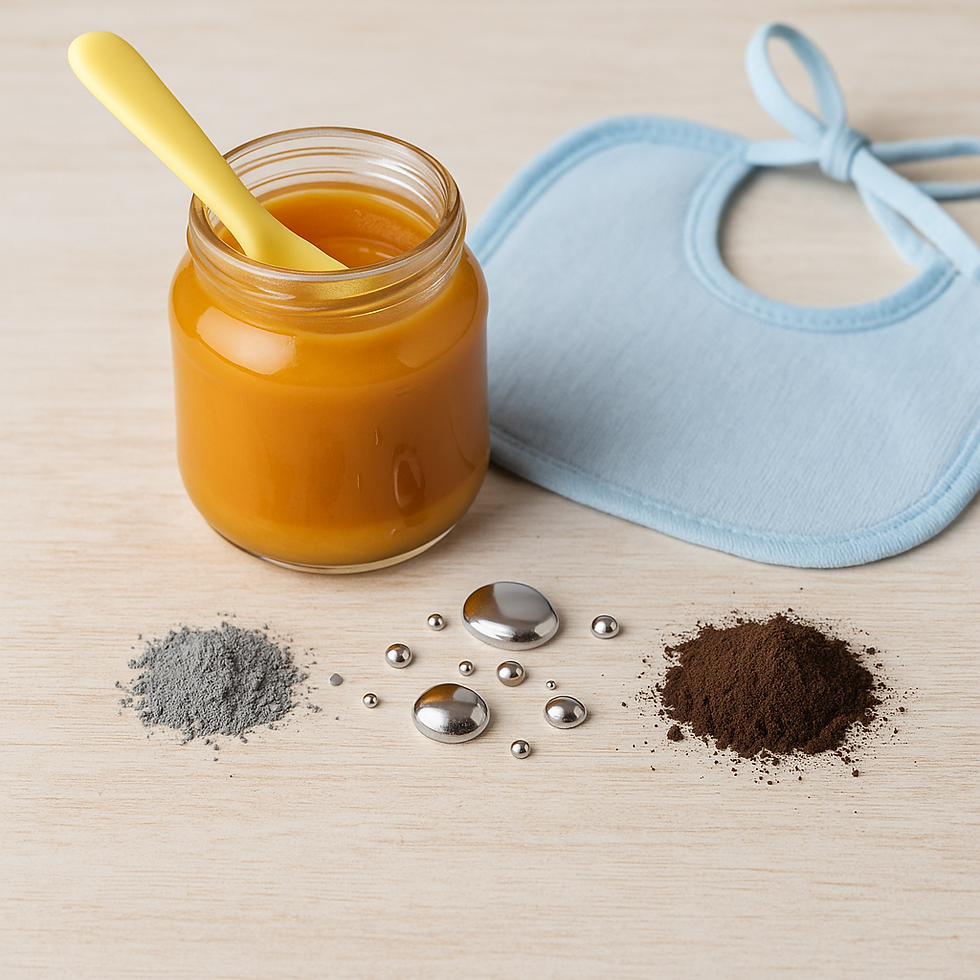Heavy Metals in Baby Food: A Silent Threat to Infant Health
- Amanda Rae
- May 22, 2021
- 4 min read

Introduction
Baby food should represent nourishment, safety, and growth. Yet, in recent years, alarming investigations have revealed that many commercially available baby foods contain dangerous levels of toxic heavy metals—including arsenic, lead, cadmium, and mercury. These contaminants, even in small doses, are linked to developmental delays, neurological disorders, and long-term health consequences. This paper explores the scope of heavy metal contamination in baby food, the systemic failures that allow it, and what parents and policymakers can do to safeguard children’s health.
What Are Heavy Metals?
Heavy metals are naturally occurring elements with high atomic weights and densities. While some, like zinc and iron, are essential in trace amounts, others—like lead, arsenic, mercury, and cadmium—are toxic even at low levels.
Arsenic: Naturally present in soil and water, especially in rice crops.
Lead: Often enters food through contaminated soil, water, or packaging.
Cadmium: Commonly found in cereals, leafy vegetables, and root crops.
Mercury: Bioaccumulates in aquatic food chains and may contaminate water sources.
Infants and toddlers are especially vulnerable due to their rapidly developing brains and organs, limited detoxification capacity, and high food intake relative to body weight.
Shocking Industry Reports
In February 2021, the U.S. House Subcommittee on Economic and Consumer Policy published a groundbreaking report titled “Baby Foods Are Tainted with Dangerous Levels of Arsenic, Lead, Cadmium, and Mercury.” The report was based on internal documents from top baby food brands including:
Gerber
Beech-Nut
Earth’s Best Organic
HappyBABY
Plum Organics
Parent’s Choice (Walmart)
Sprout Organic Foods
The findings revealed that many products contained heavy metal levels hundreds of times above what health experts consider safe. Alarmingly, these companies did not consistently test finished products—only raw ingredients—leaving a blind spot for final contamination levels.
Health Implications of Early Exposure
The developing nervous system is especially sensitive to neurotoxins. Even trace amounts of heavy metals can impair:
Cognitive development and IQ
Behavioral control (ADHD, irritability)
Language and motor skills
Immune system resilience
Growth hormone regulation
A 2012 meta-analysis in Environmental Health Perspectives found that lead exposure during infancy could significantly reduce IQ scores in children, even at blood lead levels previously considered “safe.”
These impacts are often permanent and may not appear until years later, making early detection and prevention essential.
Regulatory Gaps and Industry Oversight
In the United States, there are no mandatory limits for heavy metals in most baby food categories. The FDA's action levels—when they exist—are often outdated or non-binding.
For instance, the FDA’s action level for inorganic arsenic in infant rice cereal is 100 parts per billion (ppb), a threshold many scientists argue is far too high.
Other products, like fruit purees and snacks, have no legal limits at all.
Despite years of advocacy, progress has been slow. The FDA’s “Closer to Zero” initiative, launched in 2021, is a voluntary roadmap—not a regulatory mandate—and has yet to implement enforceable limits across all baby food types.
Why Rice Is a Major Concern
Rice is a staple in many infant cereals and snacks, yet it is notorious for absorbing arsenic from soil and water. Brown rice, in particular, retains more arsenic due to its outer layers. A study published in JAMA Pediatrics (2016) confirmed that infants fed rice cereal had higher urinary arsenic levels than those fed other grains.
To reduce exposure, pediatricians recommend diversifying grains (e.g., oats, quinoa, barley) and avoiding rice-based snacks.
The Organic Misconception
Many parents assume that organic baby food is safer—but that isn’t always the case. While organic foods avoid synthetic pesticides and GMOs, they can still contain heavy metals due to natural soil and water contamination.
This makes transparency in testing and source traceability critical, regardless of organic labeling.
What Parents Can Do
To minimize exposure to heavy metals, parents can:
Prioritize whole, homemade baby food using organic produce and varied grains.
Choose brands with third-party testing transparency.
Limit consumption of rice cereals, rice puffs, and fruit juices.
Focus on a varied diet with fruits, vegetables, and low-metal grains.
Advocate for tighter food safety laws by contacting policymakers and supporting consumer watchdog groups.
Policy Recommendations
To protect vulnerable populations, public health agencies must:
Enforce binding maximum contaminant levels for heavy metals in baby food.
Mandate finished-product testing, not just raw ingredients.
Fund independent monitoring and enforcement mechanisms.
Increase consumer education campaigns on dietary diversity and risk reduction.
Conclusion
Heavy metal contamination in baby food is not a distant or rare problem—it is a current and systemic one. Despite the industry's assurances, science shows clear cause for concern. Protecting infants requires informed consumers, evidence-based policies, and corporate accountability. In the meantime, parents can make meaningful choices to reduce risk and nourish their children safely.
References
U.S. House of Representatives Subcommittee on Economic and Consumer Policy. (2021). Baby Foods Are Tainted with Dangerous Levels of Arsenic, Lead, Cadmium, and Mercury.
Environmental Health Perspectives. (2012). Intelligence Quotient and Lead Exposure in Children.
JAMA Pediatrics. (2016). Infant Rice Cereal Consumption and Urinary Arsenic Concentration.
FDA. (2021). Closer to Zero Action Plan. https://www.fda.gov/food/closer-zero
Healthy Babies Bright Futures. (2019). What's in My Baby's Food? https://www.healthybabyfood.org




